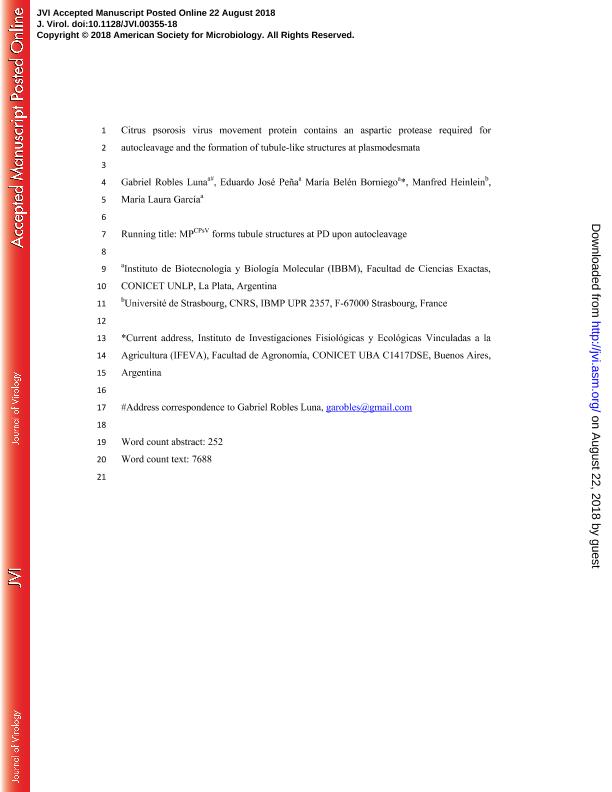Artículo
Citrus psorosis virus movement protein contains an aspartic protease required for autocleavage and the formation of tubule-like structures at plasmodesmata
Robles Luna, Gabriel ; Peña, Eduardo José
; Peña, Eduardo José ; Borniego, María Belén
; Borniego, María Belén ; Heinlein, Manfred; Garcia, Maria Laura
; Heinlein, Manfred; Garcia, Maria Laura
 ; Peña, Eduardo José
; Peña, Eduardo José ; Borniego, María Belén
; Borniego, María Belén ; Heinlein, Manfred; Garcia, Maria Laura
; Heinlein, Manfred; Garcia, Maria Laura
Fecha de publicación:
11/2018
Editorial:
American Society for Microbiology
Revista:
Journal of Virology
ISSN:
0022-538X
Idioma:
Inglés
Tipo de recurso:
Artículo publicado
Clasificación temática:
Resumen
Plant virus cell-to-cell movement is an essential step in viral infections. This process is facilitated by specific virus-encoded movement proteins (MPs), which manipulate the cell wall channels between neighboring cells known as plasmodesmata (PD). Citrus psorosis virus (CPsV) infection in sweet orange involves the formation of tubule-like structures within PD, suggesting that CPsV belongs to "tubuleforming" viruses that encode MPs able to assemble a hollow tubule extending between cells to allow virus movement. Consistent with this hypothesis, we show that the MP of CPsV (MPCPsV) indeed forms tubule-like structures at PD upon transient expression in Nicotiana benthamiana leaves. Tubule formation by MPCPsV depends on its cleavage capacity, mediated by a specific aspartic protease motif present in its primary sequence. A single amino acid mutation in this motif abolishes MPCPsV cleavage, alters the subcellular localization of the protein, and negatively affects its activity in facilitating virus movement. The amino-terminal 34-kDa cleavage product (34KCPsV), but not the 20-kDa fragment (20KCPsV), supports virus movement. Moreover, similar to tubule-forming MPs of other viruses, MPCPsV (and also the 34KCPsV cleavage product) can homooligomerize, interact with PD-located protein 1 (PDLP1), and assemble tubule-like structures at PD by a mechanism dependent on the secretory pathway. 20KCPsV retains the protease activity and is able to cleave a cleavage-deficient MPCPsV in trans. Altogether, these results demonstrate that CPsV movement depends on the autolytic cleavage of MPCPsV by an aspartic protease activity, which removes the 20KCPsV protease and thereby releases the 34KCPsV protein for PDLP1-dependent tubule formation at PD. IMPORTANCE Infection by citrus psorosis virus (CPsV) involves a self-cleaving aspartic protease activity within the viral movement protein (MP), which results in the production of two peptides, termed 34KCPsV and 20KCPsV, that carry the MP and viral protease activities, respectively. The underlying protease motif within the MP is also found in the MPs of other members of the Aspiviridae family, suggesting that protease-mediated protein processing represents a conserved mechanism of protein expression in this virus family. The results also demonstrate that CPsV and potentially other ophioviruses move by a tubule-guided mechanism. Although several viruses from different genera were shown to use this mechanism for cell-to-cell movement, our results also demonstrate that this mechanism is controlled by posttranslational protein cleavage. Moreover, given that tubule formation and virus movement could be inhibited by a mutation in the protease motif, targeting the protease activity for inactivation could represent an important approach for ophiovirus control.
Archivos asociados
Licencia
Identificadores
Colecciones
Articulos(IBBM)
Articulos de INST.DE BIOTECNOLOGIA Y BIOLOGIA MOLECULAR
Articulos de INST.DE BIOTECNOLOGIA Y BIOLOGIA MOLECULAR
Citación
Robles Luna, Gabriel; Peña, Eduardo José; Borniego, María Belén; Heinlein, Manfred; Garcia, Maria Laura; Citrus psorosis virus movement protein contains an aspartic protease required for autocleavage and the formation of tubule-like structures at plasmodesmata; American Society for Microbiology; Journal of Virology; 92; 21; 11-2018; 1-38
Compartir
Altmétricas



